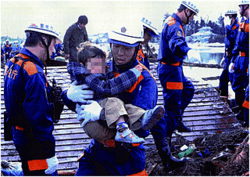Riot Police Unit

Riot Police Units (機動隊 Kidō-tai) are riot police forces and general reserves of Japanese prefectural police forces. These units were formed to respond quickly and effectively to large public disturbances, disaster relief, or other emergency situations as the core of Japanese law enforcement for crisis management throughout the country.[1][2]
Background
In the pre-war era, the Tokyo Metropolitan Police Department (TMPD) established the Special Security Unit (特別警備隊 Tokubetsu-keibi-tai). During the war, in conjunction with other prefectures, this unit was changed to the Security Unit (警備隊 Keibi-tai), but was disbanded in 1946.[3]
Only eight days later, the Guard Unit (防護隊 Bougo-tai) was created for the same role in the TMPD. In 1948, this unit was reinforced to the Police Reserve Units (予備隊 Yobi-tai).[3] These civilian police corps worked as a rapid reaction force to maintain public order against large-scale violence or other incidents. In 1957, their name was changed to the Riot Police Units. Until 1962, all Prefectural Police Departments had the same kind of units.[4]
Organization
Riot police units comprise the main strength of the Security Bureaus of each Prefectural Police Departments. Most Departments have only one unit, and in rural area, some unit are squad-size. On the other hand, some urban Prefectural Police Departments have multiple units. For example, there are ten units (nine ordinary units and one Special Vehicle Unit) in the TMPD.[5]
Each units consist of a headquarters and some companies.[6] The Public relations divisions, known as "DJ cops", are placed in each unit headquarters. They rely on eloquent and humorous speaking to prevent crowd disasters.[7]
Functional components



Basically, the equipment of the riot specialists is also the same as the regular police officers except for equipment used in riot control operations such as protective gear. But within the Riot Police Units, there are certain squads with specific equipment and training.
- Anti-firearms squads (銃器対策部隊 Jūki-taisaku-butai)
- As a response to the Kin Kiro Incident, the NPA requested the establishment of sniper teams for each Prefectural Police Departments in 1969, and until 1973, all Prefectural Police Departments had these kind of teams as a part of the Riot Police Units.[8] They were reorganized in 1996.[9] In 2002, these teams were reinforced as local counter-terrorism squads cooperating with the national-level Special Assault Teams.[10] In some urban Prefectural Police Departments, there are also Anti-firearms units with enhanced capability, such as the Emergency Response Team (ERT) of the TMPD and the Riot And Tactics Squad (RATS) of the Saitama Prefectural Police.[11]
- They're equipped with Heckler & Koch MP5 submachine guns and Howa M1500 sniper rifles.[12] Its current manpower is about 1,900 officers.[13] They serve as first response units to respond to emergencies at nuclear power plants.[1]
- Ranger squads (レンジャー部隊 Renjā-butai)
- In 1970, the TMPD established a ranger squad in their 7th Riot Police Unit. Its primary mission was search and rescue, but with their superior mountaineering skills, they also attend to hostage rescue missions such as the Asama-Sansō incident. In 2001, the squad was enhanced to four squads. Two of them are the Mountain rescue ranger squads and rest of them are the Anti-firearms ranger squads (銃器対策レンジャー部隊 Jūki-taisaku-renjā-butai), the intermediate counter-terrorism squads between the Anti-firearms squads and the Special Assault Teams.
- Counter-NBC terrorism squads
- Chemical, biological and nuclear defense squads. In some Prefectural Police Departments, they had been enhanced as an independent unit.[4] They work in coordination with the AFS and the SAT.[10]
- EOD squads
- Bomb disposal squads.[4]
Reserves
Full-time riot police units can also be augmented by auxiliary riot police units with regular police officers trained in riot duties. There are two types of auxiliary riot police units:
- Second-tier Riot Police Units (第二機動隊 Dai-Ni-Kidō-tai)
- These units operate as a reserve duty forces under control of each Prefectural Police Departments. In the TMPD, these kind of units are referred to as the Special Riot Police Units (特別機動隊 Tokubetsu-Kidō-tai).[5]
- Regional Riot Police Units (管区機動隊 Kanku-Kidō-tai)
- These units are under control of Regional Police Bureaus of the NPA for regional operations as reinforcements to the other prefectures.[4]
References
- 1 2 National Police Agency (2015). "POLICE OF JAPAN 2015" (PDF). Retrieved 2016-04-10.
- ↑ "Various Activities, Dignitary Protection" (PDF). Japanese National Police Agency. Archived from the original (PDF) on 2012-03-06. Retrieved 2010-10-13.
- 1 2 100th anniversary event Steering Committee, ed. (1974). History of the Metropolitan Police Department hundred years (in Japanese). Tokyo Metropolitan Police Department. p. 205.
- 1 2 3 4 National Police Agency, ed. (2004). "The Riot Police Units". Fifty years of the peace preservation police (in Japanese).
- 1 2 Tokyo Metropolitan Police Department. "Introduction of each Riot Police Units" (in Japanese). Retrieved 2016-04-11.
- ↑ Tokyo Metropolitan Public Safety Commission (1972-04-01). "Rules of Organization of the Tokyo Metropolitan Police Department" (in Japanese). Retrieved 2016-11-02.
- ↑ Japan Today (June 11, 2013). "'DJ Cop' at Shibuya crossing a hit on YouTube". Retrieved 2016-11-02.
- ↑ National Police Agency Police History Compilation Committee, ed. (1977). Japan post-war police history (in Japanese). Japan Police Support Association. pp. 520–522.
- ↑ 警察庁通達「銃器対策部隊の編成について」平成8年4月1日丙備発第50号
- 1 2 "Chapter IV. Maintenance of Public Safety and Disaster Countermeasures". Japanese National Police Agency. Archived from the original (PDF) on 2011-03-25. Retrieved 2011-03-25.
- ↑ Masatsugu Otsuka (July 2016). "Mobile Tactical Unit, RATS". Strike And Tactical Magazine (in Japanese). KAMADO: 12–13.
- ↑ Masatsugu Otsuka (January 2009). "Guns of the Japanese police". Strike And Tactical Magazine (in Japanese). KAMADO: 50–57.
- ↑ http://www.npa.go.jp/archive/keibi/syouten/syouten282/pdf/16_38-39P.pdf
| Wikimedia Commons has media related to Riot squads in Japan. |